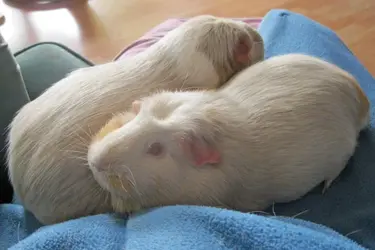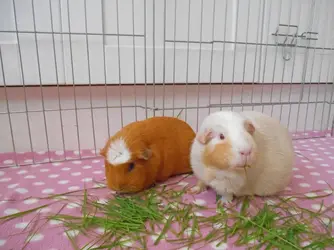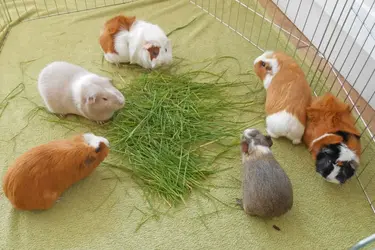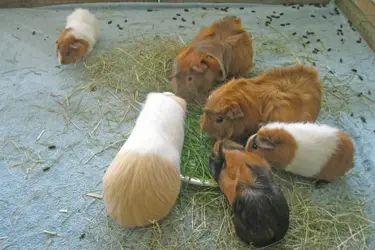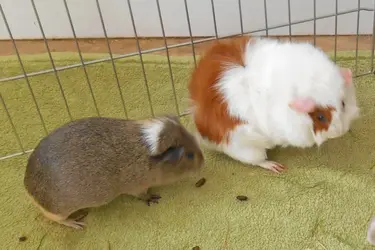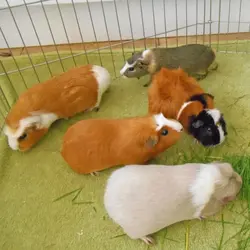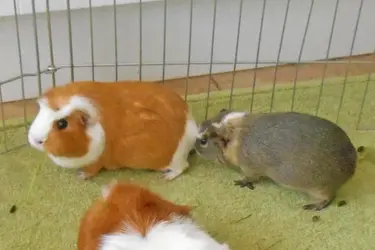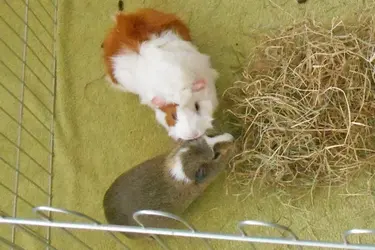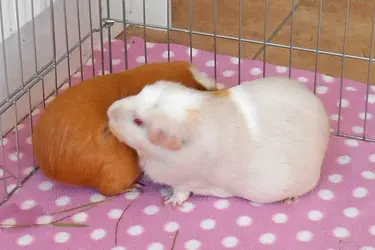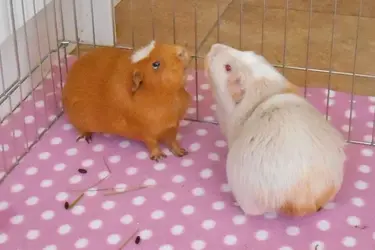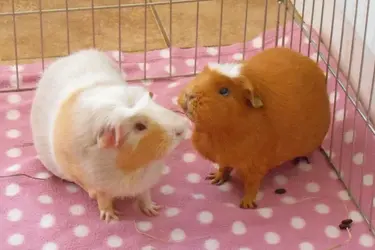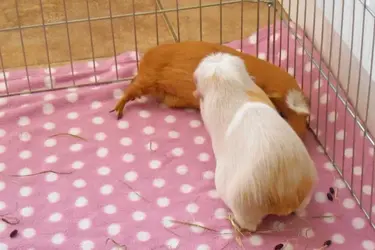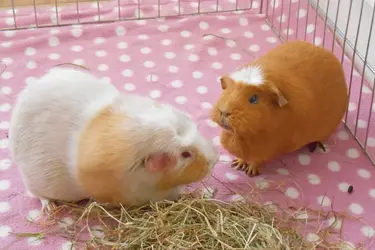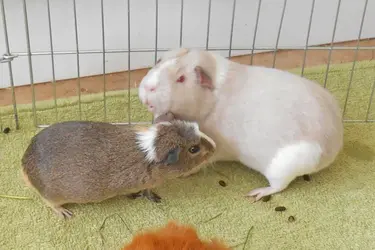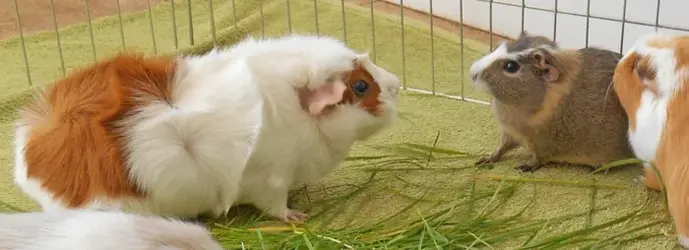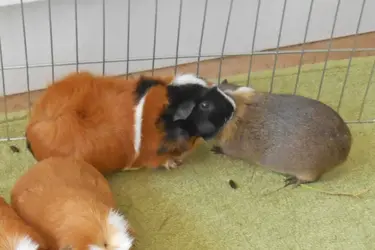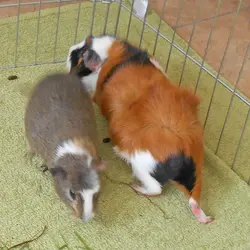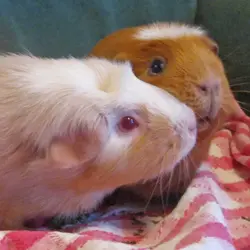1 Introduction
2 Pre-bonding
- Quarantine and sexing
- The need for a plan B
- The rule-breaker: Youngsters under 4 months (sub-teenage)
3 Setting up an introduction
- Getting to know each other
- ‘Buddy baths’ – why not
- Scent swapping - why not
- Setting up a neutral bonding area
- How to start the bonding
4 Acceptance phase: Do we like each other?
- Friendly getting to know behaviours
- Acceptance has not happened
5 Leadership phase: Establishing leadership and a group hierarchy
- When the leadership is contested
- Establishing a hierarchy when the leadership is clear
6 Special aspects
- Boar bondings
- Sow bondings
- Mixed gender bondings
- Introducing babies
- Fear-aggression
7 New territorial group establishment (ca. 2 weeks dominance phase)
8 Further helpful information guides
1 Introduction
Bonding is always a rather nerve-wracking time; this thread here will hopefully help you to understand what is going on during the key stages of an introduction.
Bonding does not start when you put two guinea pigs together; it starts ideally at least one or more days earlier, while you are preparing for it, especially by settling in newly arrived guinea pigs, quaranting and sexing them if necessary, and letting them get to know each other so you can take as many stress and risk factors as possible out of the crucial bonding itself .
It also doesn't stop when you put the guinea pigs in their cage after the bonding; it is a process that takes time, exactly like you would experience yourself when moving in with somebody you have previously not known, only that the actual guinea pig behaviours differ from our human one. Unlike us humans, guinea pigs need to play everything out in full, which in these days of political correctness can come across as the dominant guinea pig being "mean" to the submissive one. However, unlike us, guinea pigs instinctively know what is going on and understand dominance behaviours very differently.
The range of friendly and aggressive behaviours is actually the same for both genders and is understood instinctively by all guinea pigs. What differs during bonding is often the choice of behaviours. Each bonding is unique, as the dynamics depend entirely upon the setting, the characters involved and their interaction. In a successful bond, you will get mutual interest/liking and a balance of personalities that complement each other. Guinea pigs are individualists and when two individualists meet, anything can happen!
Boars more often than not will start with a rumble-strutting or humping spree (which can be mutual), whether it is with another boar or sows, while sows only mount as an expression of dominance or when in season; however, sows can also mount boars during bonding, so don't panic! Aggression in boars is generally more straightforward and easier to spot than in sows. Sows are much less upfront and bondings involving sows can can fail more often well into the dominance phase if there is a dislike or an unresolved dominance issue.
It is important that you know that any boar on boar bonding differs in one crucial point: you cannot separate boars and interrupt the bonding halfway through. Once you have committed to a bonding, you have to let the boars work it out until there is a clear success or failure. If you split because your nerves fail, you condemn your boys to start all afresh right from the beginning - and you can imagine how well that is going down with them!
Five minute tester meetings and play dates also don’t work – for guinea pigs every meeting is a proper introduction, and every separation is a prematurely aborted bonding, which is very upsetting and frustrating for them! If you stop any bonding at the first sign of dominance behaviour, your guinea pigs simply will never have a chance to bond. For them it is like a series of meetings where you are basically sent away again as soon as you say hello!
For more information on behaviours mentioned throughout the whole bonding process, you may also find out A-Z Behaviours guide helpful: A- Z of Guinea Pig Behaviours
2 Pre-bonding
- Quarantine and sexing
- The need for a plan B
- The rule-breaker: Youngsters under 4 months (sub-teenage)
3 Setting up an introduction
- Getting to know each other
- ‘Buddy baths’ – why not
- Scent swapping - why not
- Setting up a neutral bonding area
- How to start the bonding
4 Acceptance phase: Do we like each other?
- Friendly getting to know behaviours
- Acceptance has not happened
5 Leadership phase: Establishing leadership and a group hierarchy
- When the leadership is contested
- Establishing a hierarchy when the leadership is clear
6 Special aspects
- Boar bondings
- Sow bondings
- Mixed gender bondings
- Introducing babies
- Fear-aggression
7 New territorial group establishment (ca. 2 weeks dominance phase)
8 Further helpful information guides
1 Introduction
Bonding is always a rather nerve-wracking time; this thread here will hopefully help you to understand what is going on during the key stages of an introduction.
Bonding does not start when you put two guinea pigs together; it starts ideally at least one or more days earlier, while you are preparing for it, especially by settling in newly arrived guinea pigs, quaranting and sexing them if necessary, and letting them get to know each other so you can take as many stress and risk factors as possible out of the crucial bonding itself .
It also doesn't stop when you put the guinea pigs in their cage after the bonding; it is a process that takes time, exactly like you would experience yourself when moving in with somebody you have previously not known, only that the actual guinea pig behaviours differ from our human one. Unlike us humans, guinea pigs need to play everything out in full, which in these days of political correctness can come across as the dominant guinea pig being "mean" to the submissive one. However, unlike us, guinea pigs instinctively know what is going on and understand dominance behaviours very differently.
The range of friendly and aggressive behaviours is actually the same for both genders and is understood instinctively by all guinea pigs. What differs during bonding is often the choice of behaviours. Each bonding is unique, as the dynamics depend entirely upon the setting, the characters involved and their interaction. In a successful bond, you will get mutual interest/liking and a balance of personalities that complement each other. Guinea pigs are individualists and when two individualists meet, anything can happen!
Boars more often than not will start with a rumble-strutting or humping spree (which can be mutual), whether it is with another boar or sows, while sows only mount as an expression of dominance or when in season; however, sows can also mount boars during bonding, so don't panic! Aggression in boars is generally more straightforward and easier to spot than in sows. Sows are much less upfront and bondings involving sows can can fail more often well into the dominance phase if there is a dislike or an unresolved dominance issue.
It is important that you know that any boar on boar bonding differs in one crucial point: you cannot separate boars and interrupt the bonding halfway through. Once you have committed to a bonding, you have to let the boars work it out until there is a clear success or failure. If you split because your nerves fail, you condemn your boys to start all afresh right from the beginning - and you can imagine how well that is going down with them!
Five minute tester meetings and play dates also don’t work – for guinea pigs every meeting is a proper introduction, and every separation is a prematurely aborted bonding, which is very upsetting and frustrating for them! If you stop any bonding at the first sign of dominance behaviour, your guinea pigs simply will never have a chance to bond. For them it is like a series of meetings where you are basically sent away again as soon as you say hello!
For more information on behaviours mentioned throughout the whole bonding process, you may also find out A-Z Behaviours guide helpful: A- Z of Guinea Pig Behaviours
